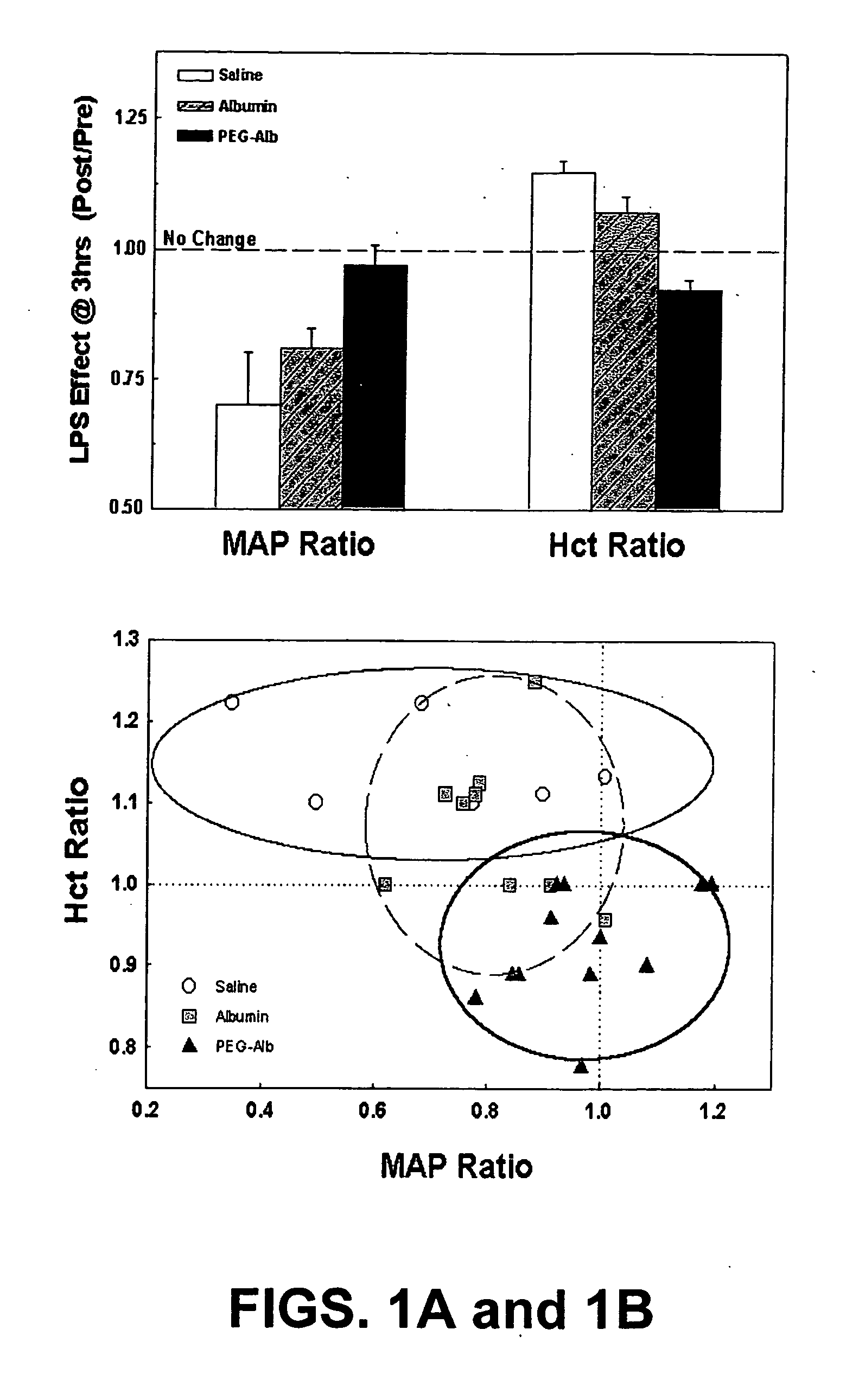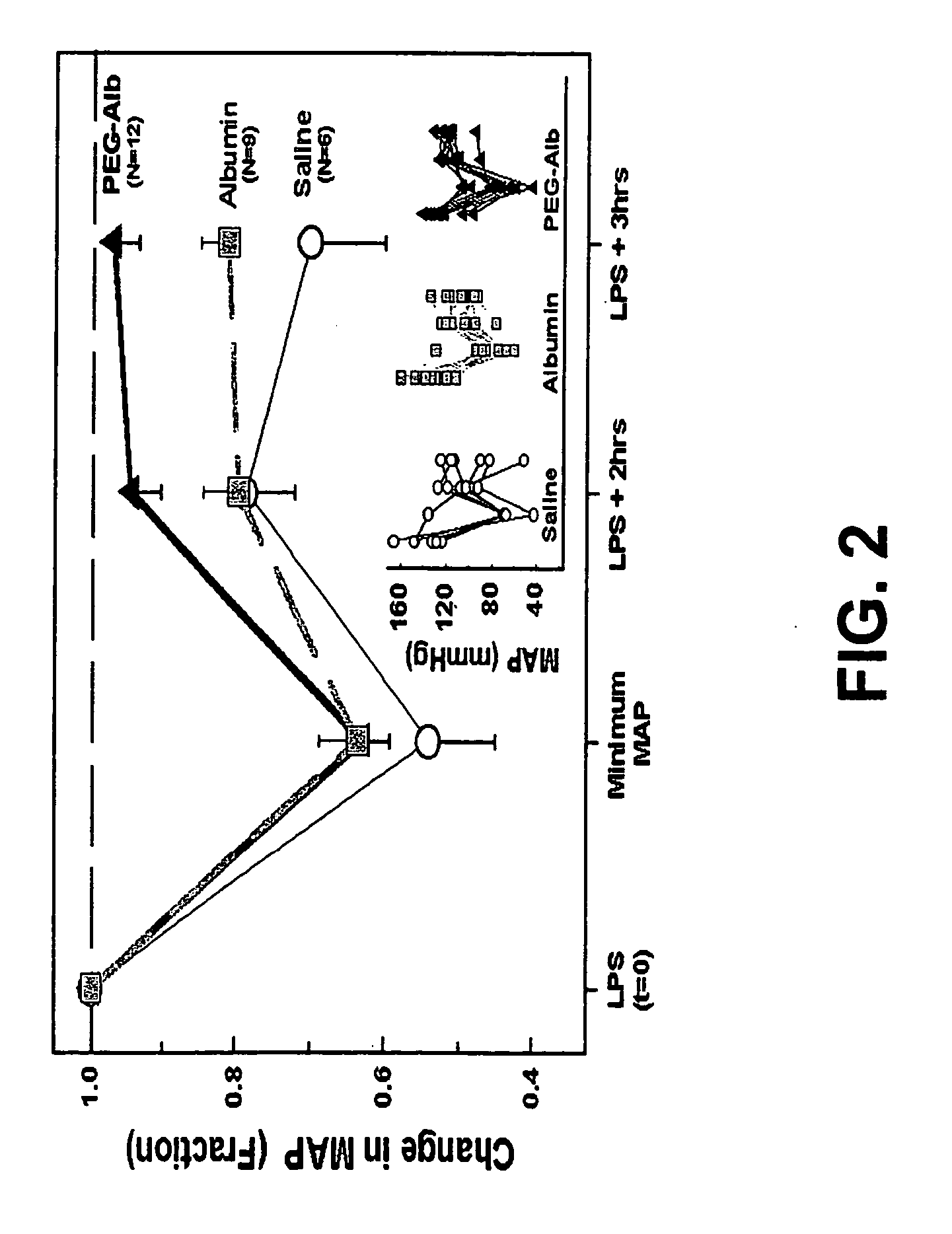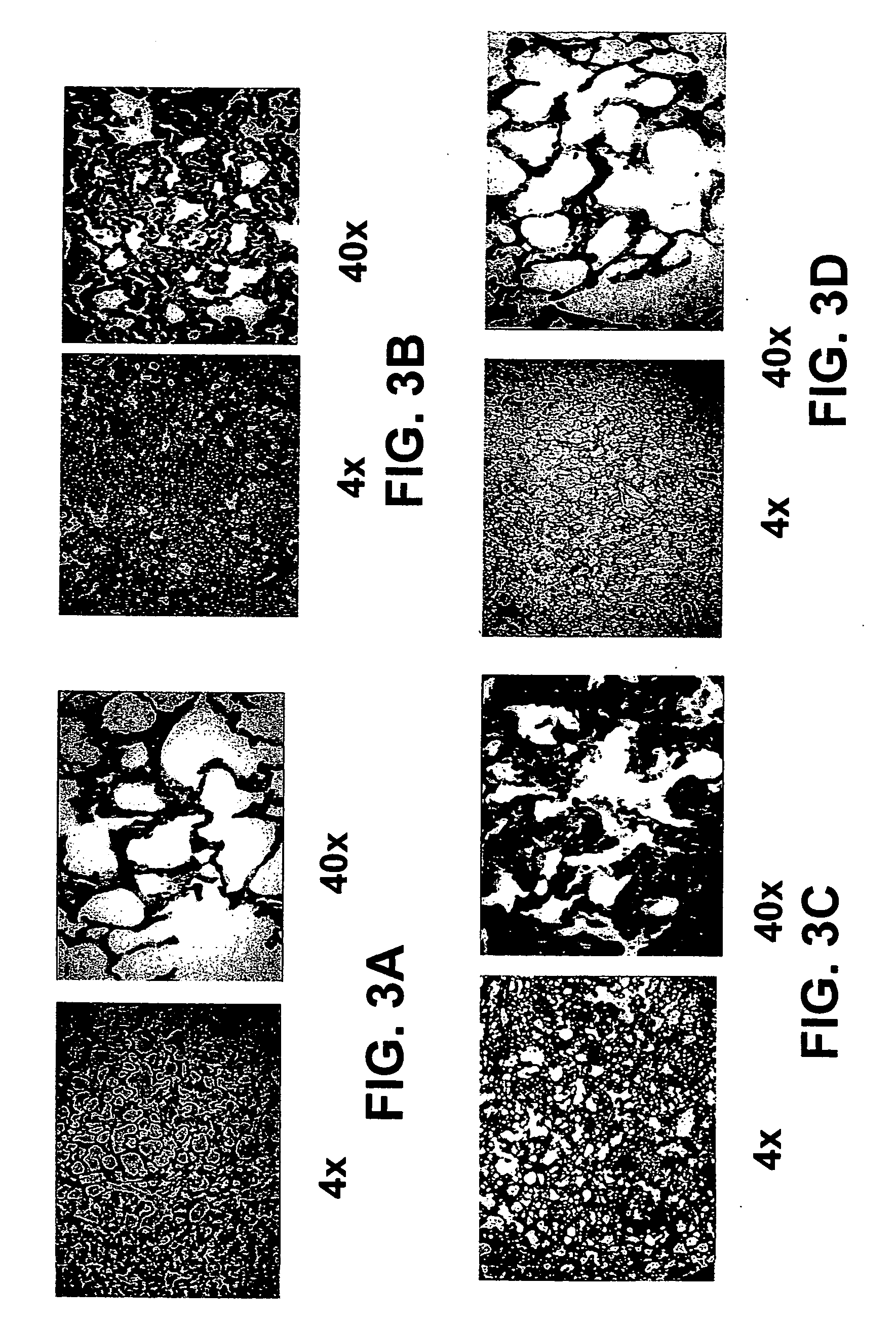Albumin-based colloid composition having at least one protected thiol region, methods of making, and methods of use
a technology of albumin and colloid composition, which is applied in the field of albumin-based colloid composition, can solve the problems of multi-organ dysfunction, high mortality, morbidity and mortality among a large number of hospital patients, and achieve the effect of not losing biological activity and not having significant toxicity
- Summary
- Abstract
- Description
- Claims
- Application Information
AI Technical Summary
Benefits of technology
Problems solved by technology
Method used
Image
Examples
example i
Use of Polyethylene Glycol Modified Albumin (PEG-Alb) in Sepsis
[0084] Materials and Methods: Preparation of PEG-Alb. 2 gms of human albumin (Sigma, St. Louis, Mo.) was dissolved in 45 ml. of 50 MM of potassium phosphate (mixture of mono and dibasic), pH 7.4. 500 mg of methoxy polyethylene glycol (Sigma, St. Louis, Mo.) was activated with cyanuric chloride and dissolved in 4 ml. of water. 1.4 ml of methoxy polyethylene glycol solution was added to 45 ml of the human albumin solution and the mixture was stirred for two hours at room temperature. The mixture was transferred to a dialysing tube (molecular weight cut off—12500) and dialysed against 3000 ml of phosphate buffered saline at 4° C. for 72 hours. The polyethylene gylcol modified albumin (PEGA) was collected and then frozen at −20° C. until its use.
[0085] Animals. Adult male Sprague-Dawley rats (Charles River Laboratories, Portage, Mich.) weighing 400-480 grams were used. Animals were housed in an American Association for Acc...
example ii
Use of PEG-Alb to Restore Vascular Volumes and Attenuate Acute Lung Injury in Endotoxin-Induced Shock
Preparation of Albumin and PEGA (PEG-Alb):
[0089] Methoxypolyethylene glycol cyanuric chloride (average Mr 5000) was added to human albumin (type V, Sigma Chemical Co.) dissolved in 50 mM KPI (pH 7.5) at 50 to 60 mg / ml with gentle stirring four times (0.2 mg per mg of albumin per addition) at 10-minute intervals at 22° C. The reaction was allowed to stir 40 minutes after the last addition of the reagent. Modification was rapid, being complete in less than 15 minutes at room temperature with the extent of modification depending primarily on the amount of reagent added. Prior to infusion into animals, both albumin and PEG-Alb were dialyzed against phosphate-buffered saline for 48 hours with three changes of buffer using high-molecular-weight-cutoff dialysis tubing (50 kDa molecular mass cutoff).
FITC-Albumin and FITC-PEG-Alb.
[0090] Human albumin (50 mg / ml) was incubated 1 hr in 50 ...
example iii
The Synthesis and Purification of Maleimide-PEG Derivatives of Human Albumin were Completed
[0117] Human albumin (Sigma Chemical Co. type V) at 50 mg ml-1 in 10 mM potassium phosphate (pH7.5), 150 mM NaCl, and 0.5 mM dithiothreitol was incubated for 1 hour at 30° C. Maleimide-methoxypolyethylene glycol 20,000 Mr (Shearwater Inc. cat. Number 2D2MOP01) or maleimide-methoxypolyethylene glycol 40,000 Mr (Shearwater Inc. cat number 2D2MOP01) was added to 1 mM and the reactions were incubated for 1 hour at 30° C. PEG-modified albumins were purified by ion exchange chromatography on Q-Sepharose) Pharmacia).
[0118]FIG. 9 shows the purification of PEG-20,000 (maleimide) modified albumin—Human albumin modified with maleimide PEG 20,000 (7 mg of protein) was applied to Q-Sepharose (1.5 cm×5 cm) equilibrated in 50 mM Tris-Cl (pH 7.5 at 25° C.). The column was eluted at 27 ml / hr and fractions of 1.5 ml were collected. Chromatography was performed at room temperature (22° C.). The column was elut...
PUM
| Property | Measurement | Unit |
|---|---|---|
| temperature | aaaaa | aaaaa |
| pH | aaaaa | aaaaa |
| MW | aaaaa | aaaaa |
Abstract
Description
Claims
Application Information
 Login to View More
Login to View More - R&D
- Intellectual Property
- Life Sciences
- Materials
- Tech Scout
- Unparalleled Data Quality
- Higher Quality Content
- 60% Fewer Hallucinations
Browse by: Latest US Patents, China's latest patents, Technical Efficacy Thesaurus, Application Domain, Technology Topic, Popular Technical Reports.
© 2025 PatSnap. All rights reserved.Legal|Privacy policy|Modern Slavery Act Transparency Statement|Sitemap|About US| Contact US: help@patsnap.com



